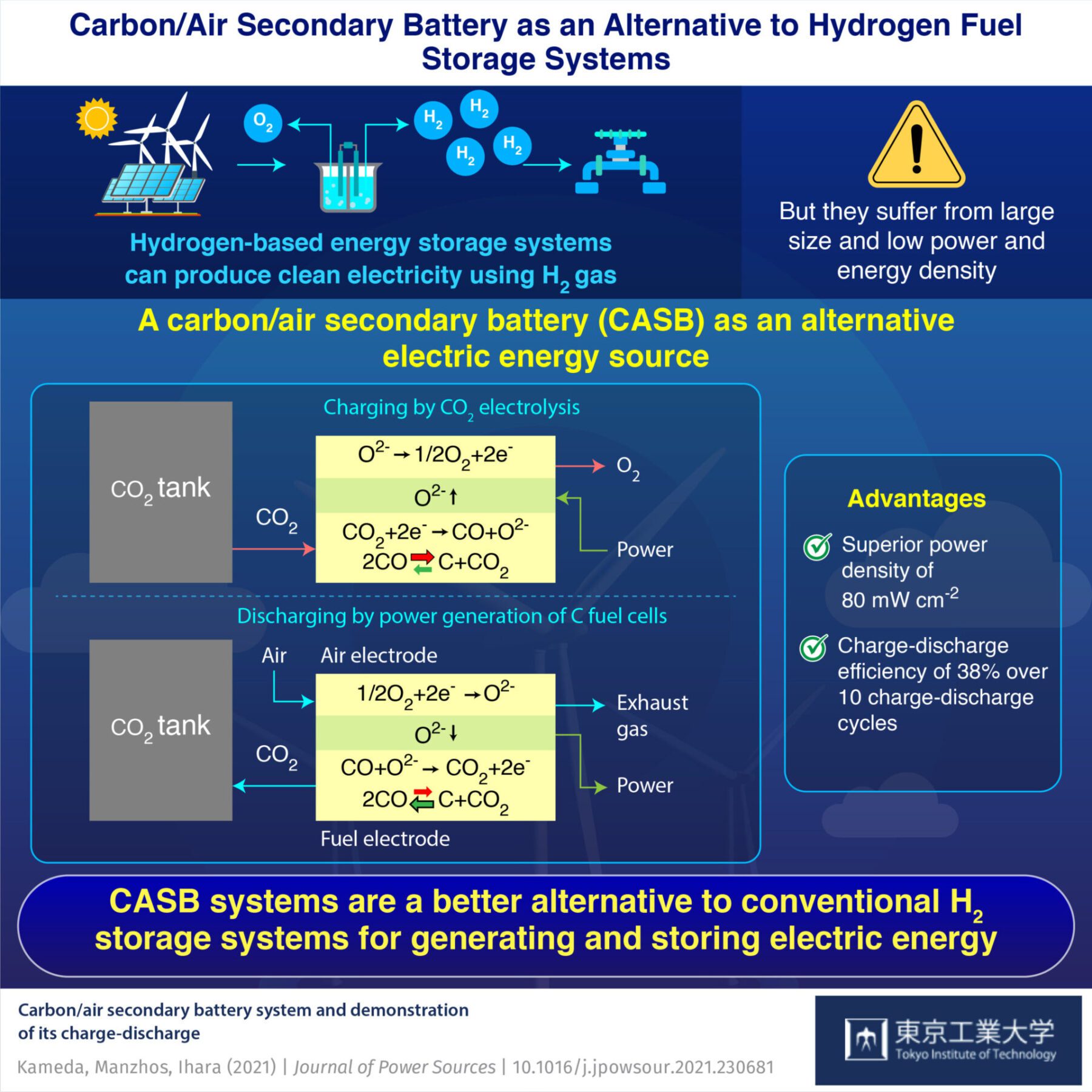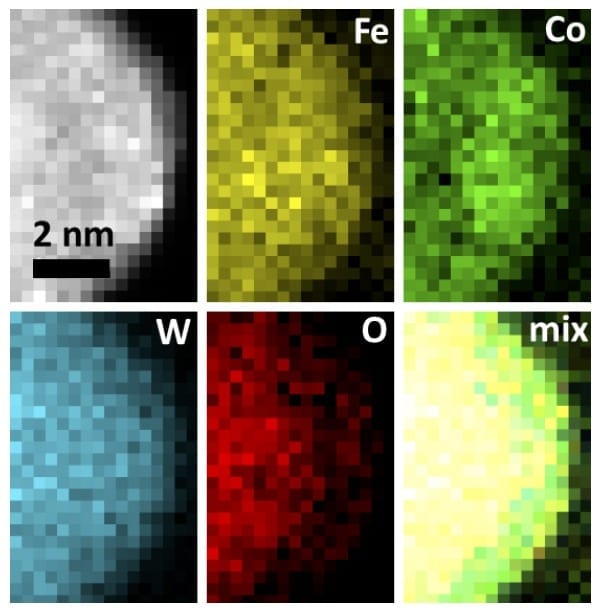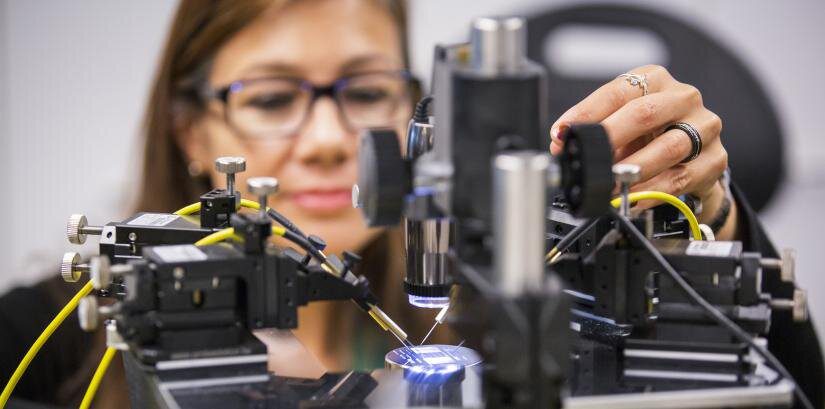
Credit: Tokyo Tech
Solid oxide large-capacity power storage system required for mass introduction of renewable energy
The point
- Developed the world’s first large-capacity solid oxide fuel storage system that combines electricity storage using CO 2 electrolysis and power generation by a chemical reaction using carbon and air.
- The theoretical discharge efficiency is 100% and has a theoretical volumetric energy density of 1,625 Wh / L, which is higher than the existing system using hydrogen gas.
- Expected to be used as a large-capacity power storage system required for large-scale use of renewable energy
Overview
Keisuke Kameda (3rd year doctoral student) and Manabu Ihara, a graduate student of the Department of Applied Chemistry, Faculty of Materials Science and Engineering, Tokyo Institute of Technology, and others store carbon dioxide (CO 2 ) as carbon (C) by electrolysis, and the carbon and air We proposed a “Carbon / air secondary battery (CASB) system” that generates electricity using the carbon dioxide (O 2 ) inside, and succeeded in demonstrating its charge and discharge. Research on the electrolysis of CO 2 and research on power generation using carbon and oxygen have been reported so far, but this research is the first to develop a system that combines both.
The CASB system developed this time is attracting attention as a large-capacity storage technology required for mass introduction of renewable energy. Hydrogen / water-power-to-gas-to-power (H 2 / H 2 O-P2G2P) [Terms Compared with 1] , the theoretical volumetric energy density [Term 2] is 1,625 Wh / L, which is higher than compressed hydrogen (379 Wh / L, 20 MPa), and the overall reaction C + O 2 ? CO 2 standard theoretical discharge efficiency. [Term 3] is 100%. In addition, since the output of the power storage system and the storage capacity can be controlled independently, it can be expected as a next-generation large-capacity power storage system. Since the CO 2 generated during discharge is stored, the system is also characterized by not emitting CO 2 .
In charge / discharge experiments using solid oxide fuel cells / electrolytic cells (SOFC / EC) [Term 4] , Coulomb efficiency [Term 5] 84% and charge / discharge efficiency [Term 6] 38% were achieved.
This research result was published in the online version of ” Journal of Power Sources ” on November 5th.
Background
The introduction of renewable energy is being promoted, but one of the major issues is how to deal with the balance between supply and demand of electricity. In other words, since the amount of power generated by solar power generation and wind power generation, which are easily affected by the weather and conditions, is not stable, there are concerns about excessive power generation to meet demand and insufficient power generation when large amounts of power are required. “Large-capacity power storage technology” is required to meet this problem.
There are some points to consider in the technological development and equipment design of large-capacity storage. For example, it is required to secure as much electricity storage as possible with equipment that is as compact as possible. It is also important that no loss occurs during charging and discharging (charging / discharging efficiency). In addition, the development and introduction of energy storage technology is under consideration based on factors such as the short time required for charging and discharging and the large amount of energy that can be extracted.
Among the many technologies, the charge / discharge method using “hydrogen” has been attracting attention in recent years. Water can be electrolyzed into hydrogen and electricity can be stored as hydrogen gas, and electricity is taken out again by generating electricity using hydrogen gas. It is called water / hydrogen-Power to Gas to Power (H 2 / H 2 O-P2G2P) because it converts hydrogen gas (Gas) and electric power (Power) to each other . Although H 2 / H 2 O-P 2G 2P has the advantage that the storage capacity and output can be set independently, it is charged because the reaction entropy change [term 7] and the latent heat of vaporization of water [term 8] due to the oxidation of hydrogen are large. One of the problems is that the discharge efficiency becomes low. In addition, since the volume of gas is larger than that of solid and the energy density per volume is small, there is a problem that a place is required for storage.
While research is underway to improve the efficiency of H 2 / H 2 O-P2 G2P and make equipment more compact, it is also important to develop and study a charge / discharge method with even higher performance. In the laboratory, we have paid particular attention to the method using carbon (C). So far, we have developed a Rechargeable Direct Carbon Fuel Cell (RDCFC) that supplies carbon by thermal decomposition of hydrocarbons and repeatedly generates electricity using carbon as fuel [References 1 and 2] .
Newly In this study, high energy density, entropy change of less than 2 kJ / mol and less carbon and CO 2 oxidation-reduction reaction C + O for 2 ?CO 2 focused on taking advantage of. Specifically, carbon is precipitated using the thermochemical equilibrium of the electrolytic reaction of CO 2 and the Boudouard reaction, and the precipitated carbon is charged and discharged by generating power in the same reaction as RDCFC.
Research result
In this research, we proposed the CASB system as a large-capacity power storage system that can generate electricity by using SOFC / EC to store electricity as carbon by electrolysis of CO 2 , and succeeded in demonstrating its charge and discharge.
The charge / discharge efficiency of 38% of the CASB system, which was successfully demonstrated in this study, was comparable to the estimated charge / discharge efficiency of H 2 / H 2 O-P2 G2P (20% to 54%). For practical use, further improvement in efficiency is desired, so we will continue to improve and develop the system in the future. In order to increase efficiency, it is necessary to develop an electrode that enables efficient use of carbon and has a low overvoltage even under carbon precipitation. In addition, for the implementation of the CASB system, it is necessary to study the charge / discharge process of the entire system that can increase the volumetric energy density and charge / discharge efficiency.
Original Article: Proposal and development of the world’s first “carbon air secondary battery system”
More from: Tokyo Institute of Technology
The Latest Updates from Bing News & Google News
Go deeper with Bing News on:
Carbon-air battery
- Lenovo ThinkPad X1 Carbon Gen 12 Review: Flagship Business Laptop Now Ultra Expensive
The latest X1 Carbon has many charms, but they will remain out of reach for many business buyers constrained by budgets.
- E-mobility's role in achieving carbon neutrality targets
The urgency to meet carbon neutrality targets has intensified, with many countries committing to ambitious goals within the next few decades. E-mobility plays a critical role in this context, offering ...
- Fiido Air review: so lightweight you’ll forget it’s an e-bike
Yes, that’s an electric bike, though you wouldn’t know it from looks alone, or from hoisting it up some stairs since it weighs as much as a regular city bike at just 30 pounds (about 14kg).
- What is a 'sand battery'? And what does it mean?
Permanent and modular lithium-ion battery systems are the most common way of storing surplus renewable energy. In fact, used electric vehicle batteries are increasingly finding a second service life ...
- What would happen if massive battery plant proposed in Morro Bay caught fire?
If one block of batteries burned at the facility while wind blew the fumes toward nearby residences, the fire would not release enough toxins to create “significant” health risks to the public based ...
Go deeper with Google Headlines on:
Carbon-air battery
[google_news title=”” keyword=”carbon-air battery” num_posts=”5″ blurb_length=”0″ show_thumb=”left”]
Go deeper with Bing News on:
Carbon air secondary battery system
- A Company Is Building a Giant Compressed-Air Battery in the Australian Outback
Hydrostor, a leader in compressed air energy storage, aims to break ground on its first large-scale plant in New South Wales by the end of this year. It wants to follow that with an even bigger ...
- Charging future EVs could take seconds with new sodium-ion battery tech
A new type of hybrid sodium-ion battery that offers both high capacity and rapid-charging capabilities could power mobile devices, electric vehicles and space tech.
- Filtration upgrades and carbon cuts for advanced gas turbines
Carbon emissions are a key business driver for many sectors, but a simple update of the filtration system can result in significant improvements in performance for gas turbines.
- Best Home Security Systems Of 2024
Commissions do not affect our editors' opinions or evaluations. Home security systems help keep your family and possessions safe while you’re home or away. The best home security systems provide ...
- Fiido Launches Air Carbon, the Lightest City e-Bike at an Unbeatable Price
Made with carbon fiber and stripped of all unnecessary items, the Air is exceptionally lightweight and minimalist, tailor-made for super-fun city rides ...
Go deeper with Google Headlines on:
Carbon air secondary battery system
[google_news title=”” keyword=”carbon air secondary battery system” num_posts=”5″ blurb_length=”0″ show_thumb=”left”]










